Error while reading file. This is an encoding problem that python is very prone to encounter when reading files. The solution is to add encoding=’ISO-8859-1′.
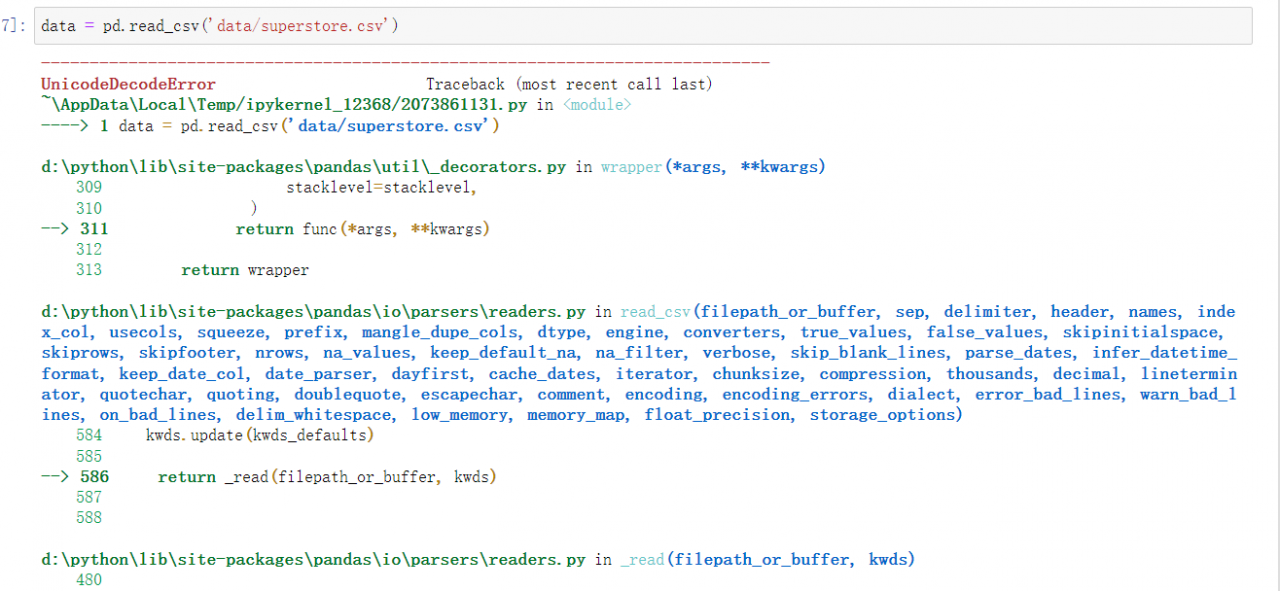

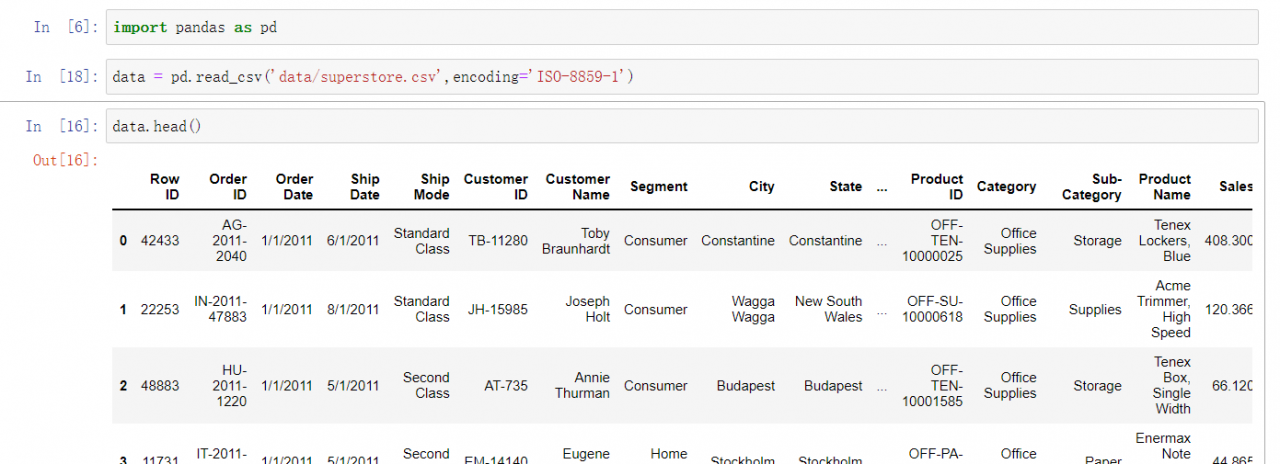
Since the default ftp download is ascii mode, the downloaded file encoding is iso8859-1.
Error while reading file. This is an encoding problem that python is very prone to encounter when reading files. The solution is to add encoding=’ISO-8859-1′.



Since the default ftp download is ascii mode, the downloaded file encoding is iso8859-1.
1 def geodistance(self, lng1, lat1, lng2, lat2): 2 # lng1,lat1,lng2,lat2 = (120.12802999999997,30.28708,115.86572000000001,28.7427) 3 lng1, lat1, lng2, lat2 = map(radians, [float(lng1), float(lat1), float(lng2), float(lat2)]) # Latitude and longitude to radians 4 dlon = lng2 - lng1 5 dlat = lat2 - lat1 6 a = sin(dlat / 2) ** 2 + cos(lat1) * cos(lat2) * sin(dlon / 2) ** 2 7 distance = 2 * asin(sqrt(a)) * 6371 * 1000 # Average radius of the Earth, 6371km 8 # Unit: meter 9 distance = round(distance, 3) 10 return distance
Here is an example code to help you get the mac address with python.
How to get the MAC Address with python
def Getphysicaladdress(self): import uuid node = uuid.getnode() macHex = uuid.UUID(int=node).hex[-12:] mac = [] for i in range(len(macHex))[::2]: mac.append(macHex[i:i + 2]) mac = ':'.join(mac) print('MAC:', mac)
1. After the installation is successful through the pip command in cmd, check the installation success in the command line
2. Running the program in pycharm still prompts the error
Set as shown below
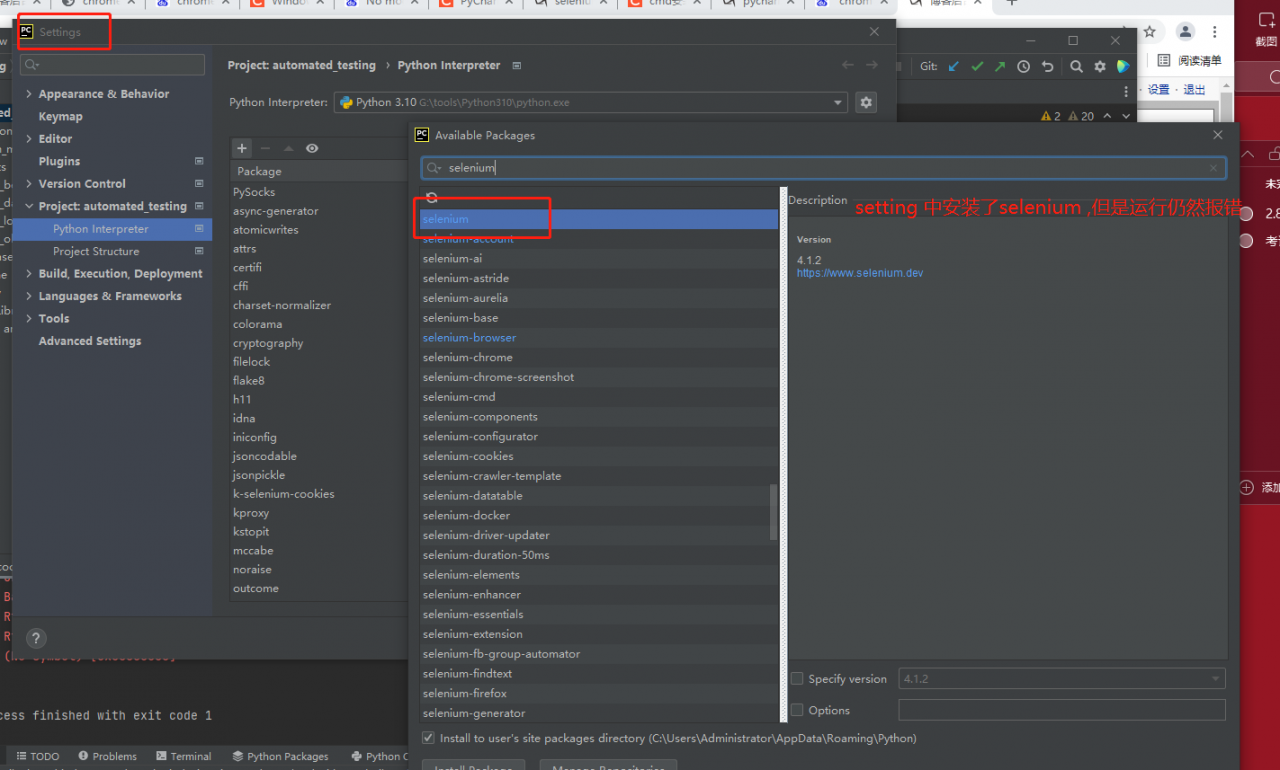
3. The python location on the first line of the runner console needs to be configured in the setting

4. Setting configuration The path of the location shown in the figure below is the same as the console output.
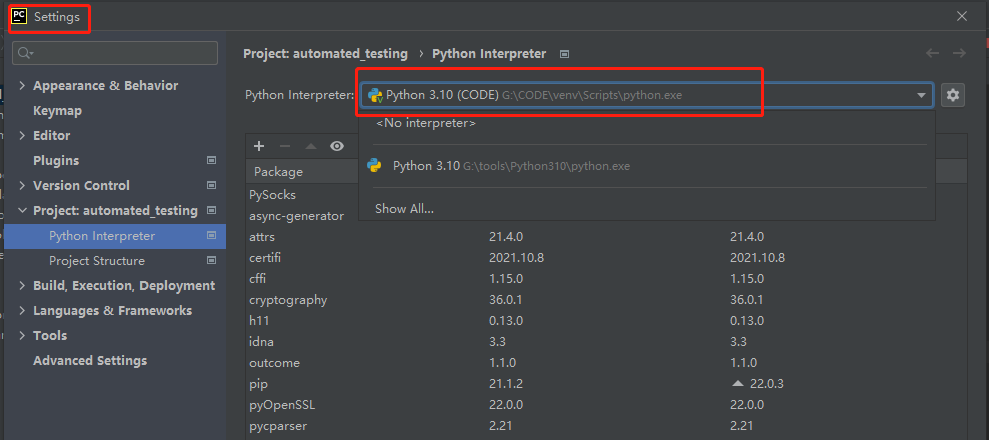
After successful execution
Background:
The project is built based on virtual environment, and the third-party packages are actually installed in:
E:\PyProject\py_basic\Lib\site-packages is not the same directory as Python installation directory
Question:
Both pycham and CMD can operate normally, but Jenkins build error:
C:\Users\86158\.jenkins\workspace\ihrm_code>python run_suite.py
Traceback (most recent call last):
File "run_suite.py", line 3, in <module>
from htmltestreport import HTMLTestReport
ModuleNotFoundError: No module named 'htmltestreport'
Solution:
Add environment variables to Jenkins. This problem is usually caused by the configuration of environment variables

Environment pycharm2021.1.1+python3.7+django3.2.11
When testing the project, I opened the python console and got django.core.exceptions.ImproperlyConfigured: Error loading MySQLdb module.
The driver is fine, the database configuration is fine, and __init__.py has added this
import pymysql
pymysql. install_as_MySQLdb()
Solution: PIP – M install mysqlclient
1. Problem code Python
self.browser.switch_to_window_handles(browser.window_handles[-1])
2. Solutions
self.browser.switch_to.window(browser.window_handles[-1])
Problem description
When using the python SDK, when logging in to China azure (mooncake) and accessing the alertsmanagement resources, you often encounter the error message “environmentcredential: authentication failed”.
Python code:
from azure.identity import DefaultAzureCredential
from azure.mgmt.alertsmanagement import AlertsManagementClient
# Acquire a credential object using CLI-based authentication.
credential = DefaultAzureCredential()
subscription_id = "xxxx-xxxx-xxxx-xxxx-xxxx"
alertClient = AlertsManagementClient(credential,subscription_id,base_url="https://management.chinacloudapi.cn/")
rules = alertClient.smart_detector_alert_rules.list()
for rule in rules:
print("Rule Name: " + rule.name)Error message:
PS C:\LBWorkSpace\MyCode\46-alertrule-python> python getrule.py
DefaultAzureCredential failed to retrieve a token from the included credentials.
Attempted credentials:
EnvironmentCredential: Authentication failed: AADSTS500011: The resource principal named https://management.azure.com was not found in the tenant named xxx Mooncake. This can happen if the application has not been installed by the administrator of the tenant or consented to by any user in the tenant. You might have sent your authentication request to the wrong tenant.
Trace ID: xxxxxxxx-xxxx-xxxx-xxxx-9e130dbf7900
Correlation ID: xxxxxxxx-xxxx-xxxx-xxxx-46769c9e1e10
Timestamp: 2022-01-27 12:09:35Z
To mitigate this issue, please refer to the troubleshooting guidelines here at https://aka.ms/azsdk/python/identity/defaultazurecredential/troubleshoot.
Traceback (most recent call last):
File "C:\LBWorkSpace\MyCode\46-alertrule-python\getrule.py", line 15, in <module>
for rule in rules:
File "C:\Users\bulu\AppData\Local\Programs\Python\Python310\lib\site-packages\azure\core\paging.py", line 129, in __next__
return next(self._page_iterator)
File "C:\Users\bulu\AppData\Local\Programs\Python\Python310\lib\site-packages\azure\core\paging.py", line 76, in __next__
self._response = self._get_next(self.continuation_token)
File "C:\Users\bulu\AppData\Local\Programs\Python\Python310\lib\site-packages\azure\core\pipeline\policies\_redirect.py", line 158, in send
response = self.next.send(request)
File "C:\Users\bulu\AppData\Local\Programs\Python\Python310\lib\site-packages\azure\core\pipeline\policies\_retry.py", line 445, in send
response = self.next.send(request)
File "C:\Users\bulu\AppData\Local\Programs\Python\Python310\lib\site-packages\azure\core\pipeline\policies\_authentication.py", line 117, in send
self.on_request(request)
File "C:\Users\bulu\AppData\Local\Programs\Python\Python310\lib\site-packages\azure\core\pipeline\policies\_authentication.py", line 94, in on_request
self._token = self._credential.get_token(*self._scopes)
File "C:\Users\bulu\AppData\Local\Programs\Python\Python310\lib\site-packages\azure\identity\_credentials\default.py", line 172, in get_token
return super(DefaultAzureCredential, self).get_token(*scopes, **kwargs)
File "C:\Users\bulu\AppData\Local\Programs\Python\Python310\lib\site-packages\azure\identity\_credentials\chained.py", line 108, in get_token
raise ClientAuthenticationError(message=message)
azure.core.exceptions.ClientAuthenticationError: DefaultAzureCredential failed to retrieve a token from the included credentials.
Attempted credentials:
EnvironmentCredential: Authentication failed: AADSTS500011: The resource principal named https://management.azure.com was not found in the tenant named xxxx Mooncake. This can happen if the application has not been installed by the administrator of the tenant or consented to by any user in the tenant. You might have sent your authentication request to the wrong tenant.
Trace ID: xxxxxxxx-xxxx-xxxx-xxxx-9e130dbf7900
Correlation ID: xxxxxxxx-xxxx-xxxx-xxxx-46769c9e1e10
Timestamp: 2022-01-27 12:09:35Z
To mitigate this issue, please refer to the troubleshooting guidelines here at https://aka.ms/azsdk/python/identity/defaultazurecredential/troubleshoot.Problem-solving:
From the error message https://management.azure.com, we know that the problem is due to the default value of Resource Principal used in AlertsManagementClient, which was not changed to base_url with the specification of
https://management.chinacloudapi.cn/ . The problem can be mitigated by specifying credential_scopes as [“https://management.chinacloudapi.cn/.default”] when constructing the AlertsManagementClient object.
The modified code is :
# pre:
alertClient = AlertsManagementClient(credential,subscription_id,base_url="https://management.chinacloudapi.cn/")
# new:
alertClient = AlertsManagementClient(credential,subscription_id,base_url="https://management.chinacloudapi.cn/",credential_scopes=["https://management.chinacloudapi.cn/.default"])
PS: when creating client objects of other resources, if you encounter the same principal problem, you can set credential_Scopes to solve the problem.
The complete code that can travel far is:
# Import the needed credential and management objects from the libraries.
from azure.identity import DefaultAzureCredential
from azure.mgmt.alertsmanagement import AlertsManagementClient
# Acquire a credential object using CLI-based authentication.
credential = DefaultAzureCredential()
subscription_id = "a9dc7515-7692-4316-9ad4-762f383eec10"
# # pre:
# alertClient = AlertsManagementClient(credential,subscription_id,base_url="https://management.chinacloudapi.cn/")
# Modified:
alertClient = AlertsManagementClient(credential,subscription_id,base_url="https://management.chinacloudapi.cn/",credential_scopes=["https://management.chinacloudapi.cn/.default"])
rules = alertClient.smart_detector_alert_rules.list()
for rule in rules:
print("Rule Name: " + rule.name)Operation results:

The correct MonitorManagementClient object to get metric_alerts and activity_log_alerts Get Alert Rule code
from azure.mgmt.monitor import MonitorManagementClient from azure.identity import DefaultAzureCredential from msrestazure.azure_cloud import AZURE_CHINA_CLOUD as CLOUD import os os.environ["SUBSCRIPTION_ID"] = "xxxxxxyour-subidxxxxxx" os.environ["AZURE_TENANT_ID"] = "your tenant idxxxxx" os.environ["AZURE_CLIENT_ID"] = "client_id_sp" os.environ["AZURE_CLIENT_SECRET"] = "pw_sp" subscription_id = os.environ["SUBSCRIPTION_ID"] credential = DefaultAzureCredential(authority=CLOUD.endpoints.active_directory) # create client client1 = MonitorManagementClient( credential, subscription_id, base_url=CLOUD.endpoints.resource_manager, credential_scopes=[CLOUD.endpoints.resource_manager + "/.default"] ) #classic my_alerts1 = client1.alert_rules.list_by_subscription() for j in my_alerts1: print(j) #log search alerts client2 = MonitorManagementClient( credential, subscription_id, base_url=CLOUD.endpoints.resource_manager, credential_scopes=[CLOUD.endpoints.resource_manager + "/.default"] ) my_alerts2 = client2.scheduled_query_rules.list_by_subscription() for j in my_alerts2: print(j) #activity alerts client3 = MonitorManagementClient( credential, subscription_id, base_url=CLOUD.endpoints.resource_manager, credential_scopes=[CLOUD.endpoints.resource_manager + "/.default"], api_version="2017-04-01" ) my_alerts3 = client3.activity_log_alerts.list_by_subscription_id() for j in my_alerts3: print(j) #metric alerts client4 = MonitorManagementClient( credential, subscription_id, base_url=CLOUD.endpoints.resource_manager, credential_scopes=[CLOUD.endpoints.resource_manager + "/.default"] ) my_alerts4 = client4.metric_alerts.list_by_subscription() for j in my_alerts4: print(j)
Outcome:
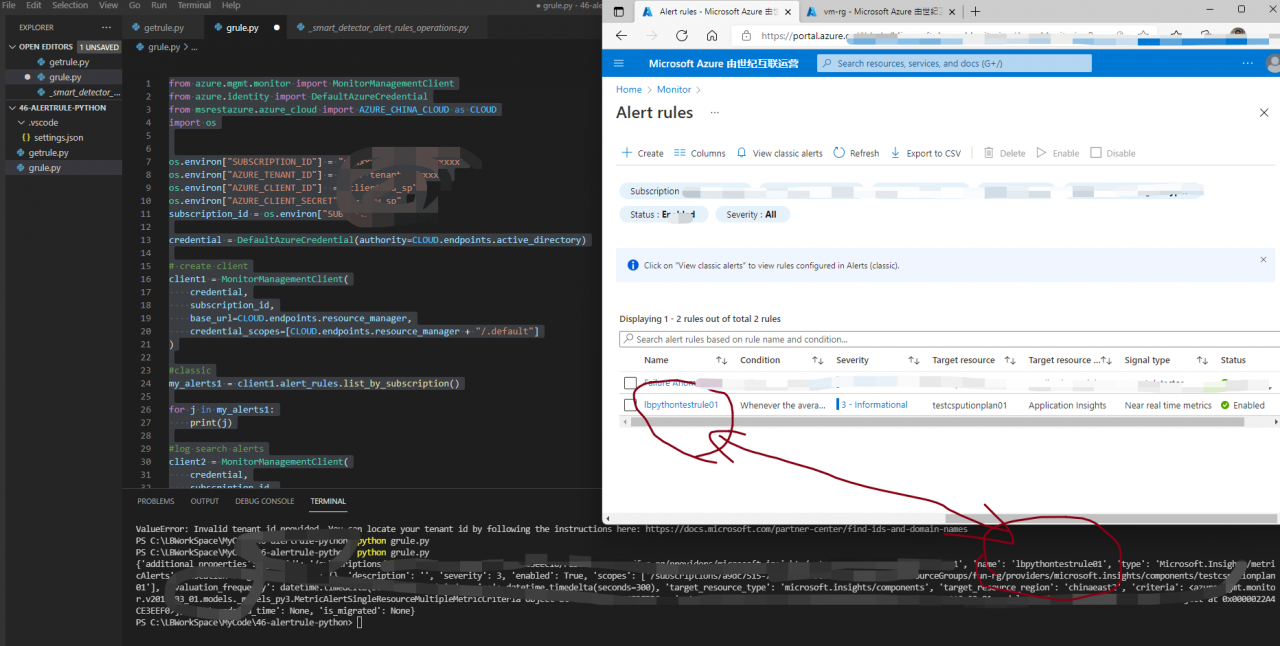
Traceback (most recent call last): File "Sy.py", line 15, in File "PyInstaller\loader\pyimod03_importers.py", line 495, in exec_module File "cv2\__init__.py", line 180, in bootstrap() File "cv2\__init__.py", line 152, in bootstrap native_module = importlib.import_module("cv2") File "importlib\__init__.py", line 126, in import_module File "PyInstaller\loader\pyimod03_importers.py", line 495, in exec_module File "cv2\__init__.py", line 180, in bootstrap() File "cv2\__init__.py", line 75, in bootstrap raise ImportError('ERROR: recursion is detected during loading of "cv2" binary extensions. Check OpenCV installation.') ImportError: ERROR: recursion is detected during loading of "cv2" binary extensions. Check OpenCV installation.
========================
Use pip to uninstall opencv, pip uninstall opencv ******* (the name of the specific opencv installation)
Go to the %:\python\Lib\site-packages% path (the path of the python installation) and delete the cv2 folder
Reinstall opencv with pip, pip install opencv****
========================
Solution (you can try in sequence).
1. reinstall cv2. (This is the answer more, most cases useful)
first pip unintall opencv-python , then pip intall opencv-python
2. set the environment variables.
3. lower cv2 version.
There is a compatibility problem between pyinstaller and cv2 version. I use pyinstaller is 4.7 (python3.8.0), cv2 is 4.5.4.58, the result is an error, lower the cv2 version to 4.5.1.48 and then package, it does not report an error.
========================
https://wiki.archlinux.org/index.php/Arch_Linux_Archive#How_to_downgrade_one_package
========================
open cmd and use pip to install a different version:
pip install opencv-python==4.5.3.56
========================
opencv-python 4.5.5.62
========================